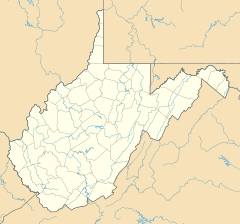Glen Ferris, West Virginia facts for kids
Quick facts for kids
Glen Ferris, West Virginia
|
|
|---|---|
|
Census-designated place (CDP)
|
|
 |
|
| Country | United States |
| State | West Virginia |
| County | Fayette |
| Area | |
| • Total | 1.626 sq mi (4.21 km2) |
| • Land | 1.376 sq mi (3.56 km2) |
| • Water | 0.250 sq mi (0.65 km2) |
| Population
(2010)
|
|
| • Total | 203 |
| • Density | 124.8/sq mi (48.20/km2) |
| Time zone | UTC-5 (Eastern (EST)) |
| • Summer (DST) | UTC-4 (EDT) |
Glen Ferris is a small community in Fayette County, West Virginia, United States. It's known as a census-designated place (CDP). This means it's a community that looks like a town but isn't officially governed as one. Glen Ferris is located on the western side of the Kanawha River.
You can find Glen Ferris about one mile south of the town of Gauley Bridge. It's also right next to the beautiful Kanawha Falls. The main road that connects Glen Ferris to other areas is U.S. Route 60, which is also called the Midland Trail.
In 2010, about 203 people lived in Glen Ferris. The community is roughly one and a half miles long. It has two churches: one Apostolic and one Methodist. A railway, owned by Norfolk Southern, runs through the village alongside U.S. Route 60.
Contents
History of Glen Ferris
Early Beginnings: The Glen Ferris Inn
The very first permanent building in Glen Ferris was the Glen Ferris Inn. It was built in 1810 and started as a private home. In 1839, a man named Aaron Stockton bought the home. He got a license to open a "common room," and that's when the building became a hotel.
The inn became quite famous. Many important people stayed there, including presidents like Andrew Jackson and John Tyler. Other famous guests included Henry Clay and the famous bird artist, John James Audubon.
The Civil War Years
During the American Civil War, the Glen Ferris Inn played a special role. It hosted officers from both sides of the war. Confederate generals Henry A. Wise and John B. Floyd stayed there. Union generals Jacob D. Cox and William S. Rosecrans also used the inn. Even future presidents Rutherford B. Hayes and William McKinley spent time at the inn. They were camped across the Kanawha River at the time.
Across the river from the inn, you can still see parts of Camp Reynolds. This was a Union Army camp and a place where they set up guns during the Civil War.
Changes to the Inn Over Time
After the Civil War, the inn became old and needed repairs. It was fixed up and had new parts added in the 1960s. A dining hall was added in the 1980s. In 1996, a local family bought the inn. They added a glass-walled dining room that looks out over the Kanawha Falls. The Glen Ferris Inn still operates as a hotel today.
Growth and Industry in Glen Ferris
After the Civil War, Glen Ferris started to grow. This was because coal mining became very popular in West Virginia. Also, the area had a lot of water, which made it cheap to create electricity.
In the early 1900s, a dam was built across the river from Glen Ferris. Trains ran on both sides of the river, carrying people and coal. In 1917, a company called Union Carbide bought a small power plant in Glen Ferris. You can still see the brick remains of this plant near the Kanawha River. It is currently being fixed up.
The Hawks Nest Tunnel and Worker Safety
Union Carbide built a much larger factory a few miles downriver in a place called Alloy. This factory was built in 1929-1930. At the time, it was the biggest factory of its kind in the world. It employed about 2800 people during its busiest years, from its construction until the early 1960s.
To power this big factory, the company needed more electricity. They built a three-mile-long tunnel through a mountain at Hawks Nest. This tunnel was meant to bring water from the New River. The rock inside the tunnel was almost pure silica. Many workers who built the tunnel became very sick from breathing in the dust. This event led to important changes in how workers are protected on the job. The nearby town of Gauley Bridge became known for the health challenges faced by the workers. This disaster was even discussed in Washington, D.C., in the 1930s. It helped people understand that certain jobs could cause specific illnesses.
Life in a Company Town
Glen Ferris followed a pattern common in mining areas. Union Carbide built most of the homes in Glen Ferris. They also built homes in other towns in the Upper Kanawha Valley. The company rented these homes to its workers and their families.
When Union Carbide was at its busiest, it also provided many things for the residents. There was a recreation hall, a post office that also served as a general store, an elementary school, a tennis court, a bowling alley, and a playground.
After the 1950s, as the factory produced less, Union Carbide began to sell the houses to the people living in them. In the 1970s, new homes were built on the mountainside above Glen Ferris. These were some of the largest homes in the area. People chose to live there for the beautiful views. In recent years, even bigger homes have been built closer to Gauley Bridge. The elementary school closed in 1961, and the Apostolic church now stands there. Today, many tourists visit the town because of the whitewater rafting on the nearby New River Gorge.
See also
 In Spanish: Glen Ferris (Virginia Occidental) para niños
In Spanish: Glen Ferris (Virginia Occidental) para niños



